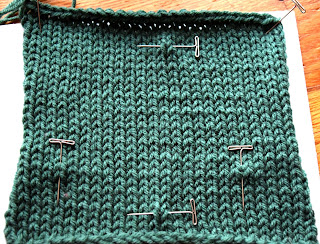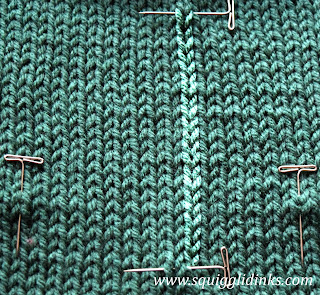It is a truth universally acknowledged that a knitter, given their preference, will never check their gauge.
(Sorry–P&P nerd moment.)
It’s true, though. Nothing makes a knitter roll his or her eyes faster than suggesting that they knit a gauge swatch. I have yet to meet someone who actually likes doing it. So why shouldyou check your gauge?
What’s the Point
When a designer creates a pattern, they use a specific yarn and set of needles. There’s a good chance that you don’t have the exact duplicates of these at home. Even if you do, (lucky duck), everyone knits with slightly different tension. My stitches may be tighter than yours, or vice versa.
Gauge enables knitters like us to replicate what a designer has done, even if we don’t use precisely the same yarn or stitch tension.
Pattern designers tell us the yarn they used and their needle size, and then they tell us the gauge, or how many stitches in a given measurement, so that if your work comes out tighter or looser than theirs, you can compensate by changing your yarn or needle size. This ensures that your finished piece will end up the size you intended, not too big or too small.
How to Do It
Begin with the needles and yarn (or at least yarn weight) the pattern calls for.
Knit a square that is at least 5 inches by 5 inches. (You need it to be big enough that you can easily measure a 4 inch square without cutting it too close to the edges.)
For my sample, I used worsted weight acrylic and size 9 needles. My clear ruler didn’t show up well in pictures, so I placed pins at the beginning and end of the 4 inches. If that makes it easier for you to see what you’re working with, you can do the same.
Measure across 4 inches side to side. How many stitches make up those 4 inches? (My sample had 15.5 stitches between the pins.)
Now measure 4 inches up and down. How many rows are included in those 4 inches? (My sample had 21 rows.)
Most often, these are the gauge numbers you’ll see in patterns. For instance: “16 stitches and 24 rows = 4 inches.”
You may, instead, see it written as stitches per inch (“4 stitches per inch”).
To get this, just divide your 4 inch numbers by 4 to get your number of stitches per 1 inch.
(In my sample, I would divide 15.5 by 4 to get 3.875 stitches per inch. In this case, I might round up to 4 for the sake of having a whole number for the pattern, but I’d try a smaller needle first—in my case, a size 8 instead of 9—to see if I could get closer to 4 stitches per inch.)
Tips for Success
- Make sure you knit your gauge swatch in the stitch pattern that you’ll be using for the project. For example, if an entire sweater is in moss stitch, don’t knit your swatch in stockinette. Each stitch pattern spreads the stitches slightly differently, so your gauge may be off if you use the wrong stitch pattern. (If you’re doing cables or lace, however, it’s generally a good idea to do your swatch in stockinette stitch, since it’s really hard to count stitches in one of those more complicated patterns.)
- Don’t stretch your swatch when you measure. You can pin it like I did to lay it flat, but don’t stretch it tight—that will change how many stitches fit into 4 inches and give you inaccurate measurements.
- If you’re going to do it, do it right. No cheats or shortcuts, please. I speak as an expert shortcutter with years of experience. My two favorite cheats and why they don’t work:
- Knitting just a 2 inch by 2 inch square and only measuring the stitches in 1 inch. Why it doesn’t work: you’re getting too small of a sample size. It may look like you have 4 stitches per inch, say, but your true measurement may be closer to 17 stitches in 4 inches. ¼ stitch per inch may not seem like much, but in a big project it’ll add up.
- Knitting a swatch that is 5 inches wide but only 1-2 inches long. It may seem like this would work if you only care how many stitches you have and not how many rows, but consider this: At your cast-on edge, the stitches are very likely to be tighter, and they don’t usually even out to normal tension until an inch or two in. The same sort of thing happens as you get closer to the needle (if you try to measure without binding off, as I have) or to the bound-off edge.
What to Do When Your Gauge Doesn’t Match
So what happens if you knit your gauge swatch and your numbers don’t match the pattern’s?
- If you have more stitches in your swatch than the pattern, your needle size is too small. (Your stitches are smaller than in the pattern, hence why more of them fit in the given measurement.) Go up a needle size and try again.
- If you have fewer stitches in your swatch than the pattern, your needle size is too large. (Your stitches are larger than in the pattern, so not as many fit in the given measurement.) Go down a needle size and try again.
- If you’re way off and nowhere near the pattern numbers, you’ll have to change to a different yarn as well as a different needle. Use the guidelines above to judge which direction (larger or smaller) you need to go, and try going a few needle sizes in that direction.
What if you don’t want to change yarns or needles but you still want to do that pattern? There’s math you can do to figure out the substitution. That’s a post (or two) in itself, though, so it’ll have to wait for another time. In the meantime, feel free to ask me questions in the comments or by email–I’m here to help!



